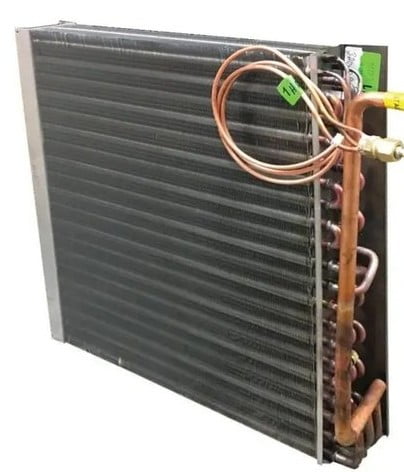Last Updated on December 1, 2023
You have to carefully adjust and organize things in your home to conserve space. If you have a portable AC, you might be wondering, if you could tilt or lay it on its side. You may do so to make any of your rooms more spacious.
Well, this article specifically covers whether you could lay a portable air AC on its side or not. And if not, why not?
Do not tilt, incline, or lay portable AC on its side or back as this deprives mechanical parts of necessary lubrication leading to compressor failure. If you have to lay it for storage, always give adequate upstanding time before operation, which is usually 24 hours for most units.
Portable ACs are designed to operate in an upstanding position only. If operated in any position other than that such as on its side, back, or at an angle, this could damage its internal fixtures.
This is especially true for compressor mounting. It is subjected to maximum vibration and is most liable to mechanical fatigue.

Why Not to Lay a Portable AC on Its Side: 5 Reasons
Portable AC can be moved from one room to another conveniently unlike most of the other air conditioners that have to be fixed at a spot. They will still need a vent hose to exhaust warm air.
Many might consider laying a portable AC on its side or back. However, this can lead to significant issues like damage to compressor and cooling coils. I will share with you how lying down your unit can hurt it.
1. Compressor Damage Due to Lack of Lubrication
Compressor is the most important component of any air conditioner operating on a vapor compression cycle.
It is in fact the only necessary moving component in the air conditioning cycle. Compressor pressurizes refrigerant that is later expanded to get the cooling effect that cools your home.
A Little About Your AC’s Compressor and Refrigerant
Most common types of compressors used in air conditioners are rotary, scroll, and reciprocating compressors. Reciprocating compressors were common in the old days.
They were mostly used with R-22 refrigerant. R-22 is an ozone-depleting substance hence it is not used anymore.
In fact, as of January 1, 2020, the production and import of R-22 refrigerant were made illegal in the US. For this reason, almost all portable air conditioners use either scroll or rotary compressors.
Why Oil Is Necessary for Your Portable AC Compressor
For any air conditioning system, oil is a vital component for its correct and consistent operation. For reciprocating compressors, oil is mandatory for lubrication, removal of heat, and for sealing purposes.
In a rotary compressor, lubrication is required for contact between cylinder and rotor. When a scroll compressor starts, the oil sump, bearings, and shaft interact with each other and form an oil supply system.

Effect of Laying Portable AC On AC Compressor
When you lay your portable AC on its side or tilt it at an angle compressor is deprived of the mandatory lubrication oil at certain zones. This causes components of the compressor to collide with each other causing wear and tear.
Result is serious damage to your compressor eventually destroying your compressor permanently and rendering it useless.
Even if the air conditioner is not operating, putting the unit on one side may affect compressor mounting. The compressor is the most expensive component of the air conditioner to replace or repair.
So, if you have to replace your compressor, it would cost a good part of the actual price of the complete unit.
In case you know the compressor has to be replaced, decide before making the decision whether it is cost-effective when your current portable AC value is taken into account. Usually, it is better to buy a new unit.
2. Damage to Internal Fixtures and AC Cooling Coils
When you lay portable AC or place it inclined, mechanical apparatus inside it will be affected i.e., mountings, fittings, and internal fixtures.
This damage could especially occur when you impulsively shift your portable AC from an upstanding position. Like sudden placement on the floor on its side or back.
An even more common and detrimental scenario is the transportation of portable AC unit. Whether your vehicle or a delivery van, sudden jerks, and impulsive movements may damage the internal system and setup.

The most I am worried about are those super thin AC coils. They are very delicate and an impact of any kind on them would leak refrigerant.
If this happens, the only option would be to change these coils and refill them with refrigerant.
3. Lower Cooling Ability of AC Refrigerant
The refrigerant inside your portable AC has to go through different physical states to bring about cooling.
Let me explain what I mean…
Actually, at different points in AC lines, your refrigerant may be a gas, a liquid, or a mixture of both.
For example, when refrigerant goes to the compressor it is in a gaseous state. It has to be otherwise there will be wet compression that may damage the compressor.
In the same way, when refrigerant moves through the condenser coils, it is converted from gas to liquid. While in the evaporator coils from liquid to gas.
These phase changes depend on heat absorbed or released by the refrigerant. This is crucial to the cooling process in a vapor compression cycle that your portable AC operates on.
When you lay portable AC on the side, oil moves in the AC lines and coils, and mixes with the refrigerant. This Interaction of oil with refrigerant inhibits its interconversion between gas and liquid.
Resultantly, the performance of your portable AC will drastically reduce and there will be a possibility of damage to it.
4. Jammed Filter Drier
A filter drier in a refrigeration system is responsible for removing moisture, contaminants, and even small amounts of lubricant oil from the refrigerant.
Lubrication oil is crucial for compressor internal components to operate smoothly. Some of it however gets added to the refrigerant and finds its way to the cooling oil.
Filter drier removes this compressor oil and allows the refrigerant to freely go through different phases to bring about cooling.
However, it is designed to contain only small quantities of oil at a time, if they travel with the refrigerant.
When you incline or lay your portable AC on its side or back, a large amount of oil travels to the cooling coils, and eventually to the filter drier, causing it to clog.
The result is a reduction in the performance and cooling effectiveness of your AC as well as its inability to remove contaminants and moisture.
5. Water from Portable AC Will Drain Directly on the Floor
Primary role of the compressor is to deliver cool air into the living space making the internal environment comfortable. It rejects heat outside by delivering hot air outdoors through a vent hose.
Your portable AC also removes humidity from the air as a secondary process called condensation.
Here’s How Your Portable AC Collects Humidity?
When the humid air comes in contact with cool evaporator coils, temperature drops below saturation temperature causing the vapors in air to convert into liquid state. This is called condensation.
Water droplets converted from a gaseous state are called condensate. Condensate drops into what is called the condensate pan by the action of gravity.
Effect of Laying Portable AC On Condensation
If your portable AC is not in an upstanding position, the condensed water will follow the path of gravity. Thereby when the unit is tilted or laying on the side, water will spill on the floor instead of collecting in the condensate pan.
Note: ‘Partially Evaporative‘ and ‘Fully Evaporative‘ are common types of portable air conditioners in the market.
They both have what is called self-evaporation technology i.e., moisture is automatically removed through the exhaust hose. Laying portable AC on its side or back will also undermine this aspect of your portable AC.

Can You Lay Portable AC On Its Side for Storage?
After winter sets in you may winterize your portable AC taking it away from your living space although it is not a necessary thing to do so.
When winterizing portable AC, it is recommended to do so in the upright position.
The critical reason is that after retrieving portable AC from storage some zones of the compressor will be deprived of oil if it was laying on the side. Operating it right away would cause damage to the compressor due to a lack of lubrication.
Anyways, if you have your portable air conditioner stored on its side, back or any position that is not upright major damage will not be caused until you turn it on. So just keep it in the default upright position without turning it on for sufficient time.
This will cause oil to recover and redistribute in the compressor. Then you may turn it on.
The time for which you should leave it upright depends on the unit you have. The safest choice though, if you have kept it in the wrong position for more than a day, is to keep it unplugged and in this position for about 24 hours.
How to Winterize Portable AC?
If you are storing your portable AC for a long time like till spring, do it right. This will maintain your portable AC, keep it working for a long time, and increase its life.
- Detach the power cord, wrap it, and store it in the storage compartment on the back of the portable AC.
- Uninstall window kit and unscrew the vent hose. Some units have special space to store them. Otherwise, store it in a secure suitable place.
- Drain the water in the condensate pan entirely by removing the drain knob to prevent corrosion.
- Extract the filters before storage, clean them, and put them back in the unit.
- Store your portable AC in a place away from direct sunlight or below-freezing temperatures. A closet, cupboard, basement etc. is preferable.
Can You Lay Portable AC On Its Side for Transportation?

When you have to move your portable AC, and you use a mode of transportation like a truck, best is to keep it in the vertical default position. Other than that it could have compressor oil deprivation and starting it in this state could damage the compressor.
But another problem could be damage to compressor mounting. It is different to place your unit stationary on its side in storage versus laying it on the side while it is moving.


